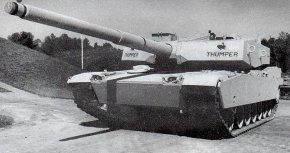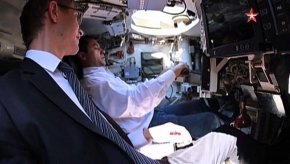Blue force tracking was a feature added to Abrams in 2003, it’s more refined now but just about every army worth the term has some form of networking and is porting it into their Armored force.
Drones are a good feature, recent IFV programs have been looking to add them and Its a logical addition in the form of a mini or nano sized drone to see over the horizon, take a peek behind the hill or building to get a lay of what might be Laying in wait. Yet these to are added to existing systems. As they emerge we may also see CUAS added to.
The Net centric is important but more so I think will be how the data is given to the user. Both the old 2003 circa FCS and far more recent IDF Carmel demonstrators showed an interest in AI interfaces Solid state touch screens. Today’s MBT are already Net centric but like an old Blackberry. These project more like an Iphone12.
Rafael’s Carmel demonstrator for example. Touch screen 2 man crew where the third operator is an AI. This was a converted surplus M113 hull so adding such isn’t impossible to an existing vehicle.

(photo source
IMOD, IDF Reveal Carmel AFV Demonstrators | Israel Defense)
Rather than one or two systems that define the generation a it’s a whole combination of evolution and revolutionary steps across the whole of the vehicle. Basically a few can be added to an existing hull type but the whole list demands the next step.
For a true Next gen of MBT, I think of it as part of a family of tracked vehicles weighing between 35-65 tons depending on configuration. This is inspired by Armata, Merkava/Nammer, Lynx, Boxer, K2, Type 10, FCS MCS, VT-5/VN17, Leclerc, SEP Griffin III, Leopard Evolution, and the Polish PL01 concept.
Powered by a conventional engine mated to an electric drive. The combination used as the electric drive is lighter and demands less maintenance Well being cooler in IR. The conventional engine serves as the main generator with a reserve battery. If the main engine is knocked out you could still possibly crawl home battery power. It would act like a hybrid car. If you are sitting waiting you can use the battery, if you use that up you turn on the engine. If you are low speed maneuvers like the Eastings crawl it’s all electric. If you are following a Patton style blitz you are on the engine.
A must would be a full suite of advanced armor modules mounted around the hull. If it’s a low threat area or being shipped you can strip it down. In a high threat area add on the armor or mix armor types. Like AMAP armor tailor the armor to meet the needs. This already exists.
Augmented by a mix of soft (Smoke, Dazzler, decoy) and hard kill APS. Perhaps even passive detection denial tech, Although there have been attempts at active Stealth tiles those don’t seem to be ready yet.
So this would probably be a passive camouflage system made of a combination of smart netting (Saab Barracuda) and shaped tiles (like Tacticam from armorworks seen on GDLS Griffin III demonstrator AUSA2019) to confuse radars and IR imagers.
The vehicle would have a fully active Hydropneumatic suspension bolted on the sides.( Like K2 and type 10.) This means it can be replaced easily. Like WW2 American or British tanks if a bogie breaks just swap it off for a new one. These would also adjust how the vehicle stands based on terrain or crew wants, Sitting low to conceal more of the vehicle behind an embankment, leaning back to get higher gun elevation or front For more gun depression or standing up for more ground clearance. Lower weight configurations might use band tracks making them even lighter road friendlier at higher weight end conventional tracks.
Operated by a crew of 0... Well some versions might be 0. I mean do you need a crewman in the actual bridge layer or can you have them ride in a JLTV that drives with it? Some as high as a dozen. Unmanned ground vehicles are a coming deal to. Besides if you are moving the tank around the repair area having it remote controlled might be advantageous. The heart of this is Drive or Steer by wire. It what would allow any position in the vehicle to be driver.
Of course for an MBT you want a crew of at least 2, The Driver and Commander with the gunners functions taken by the AI. 3 is still an option. But two seems the want.
The external vision is a series of electro optics mounted in the hull for the driver giving as close to 360* perspective.
Another set in the turret giving the commander a full view. For both not just on tablet displays but in head mounted ones to. With tethered parascope drone to give a overhead view or launched mini drone to probe around. Additionally audio (Boomerang mics) and radar sensors As well as tech like radio direction finding to farther assist.

(GDLS Griffin III Demonstrator in Army hands presumably. Very recent photo as indicated by masks photo source
General Dynamics Griffin III Candidate to Replace M2 Bradley Infantry Fighting Vehicle - MilitaryLeak)
Most of the time they would operate by combination of conventional vision ports and large sold state touch screen multifunction displays and conventional controls perhaps even game style controllers as well as even being able to stand outside the vehicle like modern tankers. In combat buttoned up or when they need more detail they would use helmet mounted displays. Networked but to a higher degree.
This differs from Armata in that that is a series of multifunction displays on the bulkhead. Where in this would be I think more immersive. Like a virtual windscreen of OLED displays mated to Iron Vision. Seeing through the hull.
Gunnery is a combination of the Commander who selects the target and pulls the trigger As well as the AI that slews and confirms the shot and assists in hunting for more targets. Like a modern tank you probably have three guns. The main, coax and commanders. All three automated to degrees.
The main could be an improved 120/125mm In either longer and or lighter weight types. or go up to a beefy 130mm, 140mm. basically right now the gun seems more an evolutionary step. Mostly it’s what goes on in pointing the gun rather than the gun that is changing.
The Main gun serviced by an Autoloader. France, Japan, South Korea have proven that a Bustle mounted system can work with production tanks.
Round types being an AMP type High explosive, Sabot type long rod, With possibly BLOS Top attack Munitions like SMart 155 or KSTAM II. Seem a safe bet.
The coax And Commanders weapon would probably remain the normal combination of .30 cal and .50cal. Although the flirtation with heavier has happened it never seems to catch.

 dambiev.livejournal.com
dambiev.livejournal.com

 andrei-bt.livejournal.com
andrei-bt.livejournal.com
 andrei-bt.livejournal.com
andrei-bt.livejournal.com







